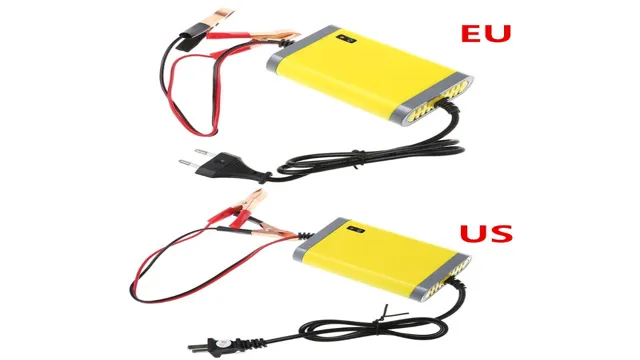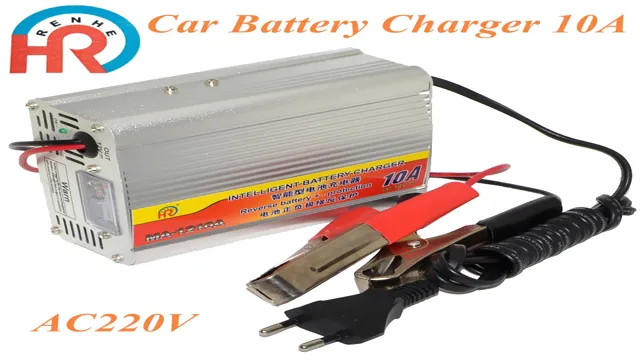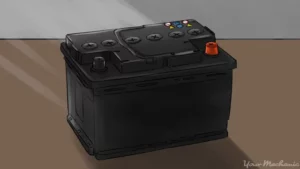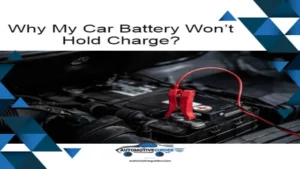Have you ever found yourself in a situation where your car battery has died, and you need to charge it to get back on the road? If yes, then the answer to your problem is simple – plug in a car battery charger. A car battery charger is a device that connects to your car battery and charges it up to keep your vehicle running smoothly. But how do you plug in a car battery charger? It may seem daunting, but it is quite simple and easy to do, even for beginners.
All you need is a little bit of knowledge and basic know-how to start. In this blog post, we will guide you through the steps on how to plug in a car battery charger. From checking the battery’s voltage to connecting the charger cables correctly, we will cover everything you need to know to ensure a successful charging experience.
So, let’s get started and learn how to plug in a car battery charger to give your vehicle the juice it needs to get back on the road.
Introduction
Are you not sure how to plug in a car battery charger? It’s a simple and straightforward process, even for those who are not mechanically inclined. First, locate the battery on your vehicle and make sure both your charger and vehicle are turned off. Secondly, attach the charger’s positive cable or red connector to the positive terminal on the battery.
Thirdly, connect the negative cable or black connector to the negative terminal on the battery. Finally, turn on the charger and wait until it indicates a full charge. Remember to disconnect the charger’s cables in the reverse order you connected them, starting with the negative cable or black connector first, followed by the positive cable or red connector.
Charging your car battery regularly can help prolong its lifespan and keep you on the road for longer. So, now that you know how to plug in a car battery charger, don’t hesitate to give it a try the next time your car battery needs a boost.
Why charging your car battery is important
As electric cars become more prevalent on our roads, it’s important to understand the importance of maintaining their batteries. Just like any other type of battery, electric vehicle batteries will eventually lose their charge over time, and this can lead to a range of problems. For one, a low battery can reduce the range of your vehicle, meaning you won’t be able to travel as far as you normally would before needing a recharge.
Additionally, a depleted car battery can put extra strain on the car’s electrical systems, potentially leading to more significant damage in the long run. That’s why regular charging is so important to keep your car running smoothly and maximize its lifespan.

Types of battery chargers available
When it comes to battery chargers, there are a variety of options available to suit different needs. From portable chargers to wall-mounted chargers, finding the right one can seem overwhelming. However, understanding the different types of battery chargers can help narrow down the options.
Some common types include trickle chargers, fast chargers, and smart chargers. Trickle chargers are great for maintaining the charge on a battery over time, while fast chargers are ideal for quickly charging a battery in a short amount of time. If you want a charger that can monitor the battery and adjust charging accordingly, a smart charger may be the best option.
Ultimately, it’s important to consider factors like the type and size of battery being charged, as well as personal preferences, when selecting a battery charger.
Step-by-Step Guide
Learning how to plug in a car battery charger is a crucial skill that all drivers should have. It’s a simple process that only requires a few steps. Firstly, locate the battery in your vehicle.
It’s usually located under the hood, but sometimes it can be found in the trunk or under the rear seat. Next, turn off your vehicle and make sure that all of the electronic devices are turned off. Then, connect the red clip of the charger to the positive terminal of the battery and the black clip to the negative terminal.
Make sure that you connect the clips securely and in the correct order to avoid sparking. Finally, turn on the charger and wait for it to fully charge the battery. Once the battery is fully charged, disconnect the charger in the reverse order that you attached it.
Remember to always follow the safety instructions provided by the manufacturer when using a battery charger.
Step 1: Select a charger
When it comes to selecting a charger, there are many different options available. Whether you’re looking to charge your phone, tablet, or other electronic devices, it’s important to choose a charger that is compatible with your device and meets your specific needs. One of the most important factors to consider is the charging speed.
If you need to charge your device quickly, you’ll want to look for a charger with a high wattage or amperage. Another consideration is the type of port your device uses. Some devices use USB-C ports, while others use lightning or micro-USB ports.
Make sure to choose a charger with the correct type of port for your device. Additionally, you may want to consider whether you need additional features, such as multiple USB ports or a built-in battery pack. By taking these factors into account, you can select a charger that will keep your devices charged and ready to go whenever you need them.
Step 2: Position the charger near the battery
To charge your battery, it is crucial to position the charger near the battery. This step is often overlooked but plays a significant role in the charging process. Placing the charger close to the battery ensures that the charging process is efficient and effective.
The charger needs to be as close as possible to the battery, and the charging cables need to be long enough to reach the battery without straining. Keep in mind that the charger’s positioning can affect the charging time and the battery’s overall health. Therefore, it’s necessary to position the charger correctly and invest in long enough cables to avoid pulling or damaging the cables during the charging process.
By placing the charger near your battery, you’re taking a step toward efficient, effective charging that will extend the life of your battery.
Step 3: Connect the charger to the battery
Once you have placed the battery in the vehicle, the next step is to connect the charger to it. But wait! Before proceeding, ensure that the charger is suitable for the type of battery you have. Once you have verified that, take the charger cables and attach the red clip to the positive terminal of the battery.
You’ll know it’s the positive terminal as it will be marked with a “+” sign or colored red. Then, take the black clip and attach it to the negative terminal of the battery. Once you’ve connected both clips to the correct terminals, plug the charger into a power source.
The charger should indicate that it’s charging the battery. Make sure to keep an eye on the battery and the charger to avoid overcharging. When the battery is fully charged, disconnect the clips in reverse order – black first, followed by red.
It’s as simple as that! Just a few easy steps and you are good to go.
Step 4: Set charging settings (if applicable)
When it comes to electric cars, one of the most important things to consider is charging settings. This is especially true if you have a long drive ahead of you. The good news is that many modern electric cars come equipped with charging settings that allow you to customize how and when your vehicle charges.
Some models even have the ability to automatically adjust charging based on the time of day or electricity rates. This means you can save money on your energy bill and ensure your vehicle is always ready to hit the road when you are. To make the most of your charging settings, be sure to consult your owner’s manual and follow the manufacturer’s recommendations.
By doing so, you can ensure that your electric car is always charged and ready to go when you need it most.
Step 5: Start charging the battery
Now that you have cleaned the battery and checked its voltage, it’s time to start charging it. Make sure to read the instructions that came with your charger and connect the right cables accordingly. Some chargers come with a built-in safety feature that automatically stops charging the battery once it has reached full capacity, preventing overcharging.
If your charger doesn’t have this feature, it’s important to keep an eye on it and unplug it once the battery is fully charged. Overcharging the battery can damage it and shorten its lifespan, so be sure to follow the instructions carefully. Once the battery is fully charged, disconnect it from the charger and reconnect it to the device it powers.
Test it to ensure it’s working as expected, and you’re good to go! Remember to recharge the battery regularly to keep it in good condition and avoid any unexpected power outages.
Precautions to Take
Plugging in a car battery charger may seem like a straightforward task, but it’s important to take precautions to ensure your safety and the safety of your vehicle. Before plugging in the charger, make sure the car is turned off and the keys are removed from the ignition. Additionally, it’s recommended to wear protective gloves and eyewear to prevent any potential accidents or injury.
It’s also essential to read the instructions provided by the manufacturer to ensure you’re using the charger correctly and using the appropriate settings. Lastly, make sure the battery terminals are clean and free from any corrosion or rust before plugging in the charger. By taking these simple precautions, you can safely and effectively charge your car battery and avoid any potential mishaps.
Precautions when connecting the charger
When connecting your charger, it’s important to take some precautions to ensure the safety of both yourself and your device. Firstly, make sure that you are using an original charger from a reputable brand. Using a fake or cheap charger may save you some money, but it could damage your device and even cause a fire or an electrical shock.
Secondly, always inspect your charger and cable for any physical damage or signs of wear and tear before plugging it into either the power socket or your gadget. If you notice any damage, replace the charger immediately. Additionally, make sure that you don’t leave your device charging for too long, as this could lead to overcharging and shorten your battery lifespan.
Lastly, avoid using your device while it’s charging as it may overheat and also shorten your device’s battery life. By taking these simple precautions, you’ll be able to charge your devices safely and avoid any potential risks.
Precautions while charging the battery
Precautions while charging the battery When it comes to charging the battery, there are a few precautions you should take to ensure both your safety and the longevity of your battery. First and foremost, follow the manufacturer’s instructions carefully and use only the charger that came with your device. Avoid using third-party chargers that may not be compatible and could cause damage to your battery.
Make sure the area around the battery and charger is clean and free of any flammable materials, as overheating may occur during charging. Additionally, always monitor the battery while it’s charging and avoid overcharging, as it can cause the battery to lose its ability to hold a charge. It is also important to avoid leaving the charger plugged in overnight or unattended for extended periods.
This can cause the charger to heat up and could potentially lead to a fire. Finally, if you notice any signs of damage to the charger or battery, including frayed cords or bulging batteries, stop using them immediately and contact the manufacturer or a professional for repairs or replacement. In summary, following these simple precautions while charging your battery can help ensure the safety and longevity of your battery and prevent potential hazards.
Remember to always read the instructions carefully, avoid using third-party chargers, keep the area clean, monitor your battery, avoid overcharging, and immediately stop using any damaged components.
Conclusion
In summation, charging a car battery may seem daunting at first, but with a few easy steps, you’ll be plugging and playing in no time. Just remember to disconnect the negative cable, attach the charger to the positive and negative terminals, and let the charger work its magic. And if all else fails, just stick a plug in it and give it a jolt of electricity.
..just kidding, don’t actually do that.
Happy charging!”
Summary of steps to plug in a car battery charger
Plugging in a car battery charger is a simple process, but it’s crucial to take certain precautions before doing so. First, ensure that the charger is detached from the outlet and switch it off before plugging it into the battery securely. Also, double-check that the charger is appropriate for your type of battery and that it has sufficient amperage for your battery’s size.
It’s also necessary to wear protective gear, such as gloves, in case of any mishaps. You should also check the water level in the battery before connecting it to the charger and keep it in a well-ventilated environment. Finally, ensure that the battery’s terminals are clean before attaching the charger, as this will ensure a secure connection.
By taking these precautions, you can keep yourself safe while charging your car’s battery, ensuring that it stays in excellent working condition.
Final tips and recommendations
As with any form of exercise or physical activity, it’s essential to take precautions when practicing yoga. One of the most critical things to keep in mind is to listen to your body and not push yourself too hard, even if you’re trying to achieve a specific pose or level. Flexibility differs from one person to another, and trying to contort yourself into a pose that your body isn’t ready yet can lead to injuries or muscle strains.
Additionally, it’s essential to use the right gear and equipment, such as a non-slip mat and comfortable clothes that allow you to move freely. Another tip is to practice under the guidance of a qualified instructor, especially if you’re new to yoga. They can help you achieve proper alignment, prevent injury, and modify poses for your specific needs.
Lastly, stay hydrated before, during, and after class, as yoga can be physically demanding and cause you to sweat. By taking these precautions, you can experience the mental and physical benefits of yoga safely and effectively.
FAQs
What equipment do I need to plug in a car battery charger?
You will need a charger, a compatible battery, and the necessary cables to connect the two.
How long does it take to fully charge a car battery with a charger?
This can vary depending on the charger and the size of the battery, but generally it can take anywhere from several hours to overnight.
Can I use a car battery charger to jump-start my car?
No, a charger is not designed to provide the sudden burst of power needed to jump-start a car. You will need a jump starter or jumper cables for that.
Do I need to remove the battery from the car to charge it?
No, you can charge the battery while it is still connected to the car, but make sure to follow proper safety precautions and disconnect the negative cable before connecting the charger.
What should I do if the battery does not seem to be charging?
Check the connections to make sure they are secure, and verify that the charger is functioning properly. If the problem persists, the battery may need to be replaced.
Is it safe to leave the battery on the charger after it is fully charged?
Most modern chargers are designed to automatically switch to a maintenance or trickle mode once the battery is fully charged, which is safe to leave on for extended periods of time.
Can I use a car battery charger on other types of batteries, such as those for boats or RVs?
It depends on the charger and the battery type. Make sure to check the specifications and compatibility before attempting to charge any battery other than a car battery.






